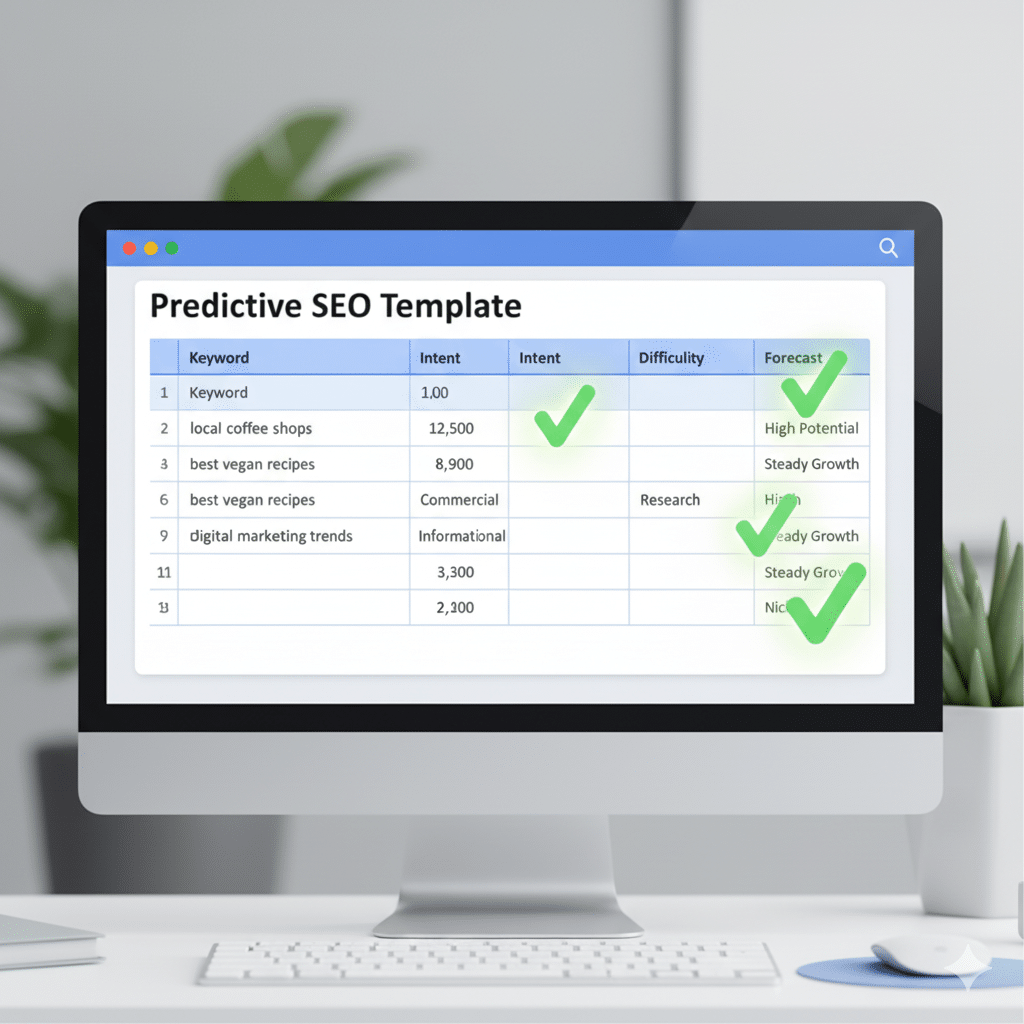The Best Predictive SEO Template Free
Okay, so predictive SEO… it sounds kinda fancy, right? Like, you’re peeking into the future with some crystal ball.
But honestly, it’s not magic it’s just taking past data and trends and trying to guess where search is headed. If you’re sick of always chasing Google’s algorithm after the fact, then yeah, predictive SEO can save you.
And yes predictive SEO template freeer in this post (keep scrolling, don’t skim too fast 😅) latI’m dropping a .
Why Predictive SEO Even Matters

Think about it: most people only react when traffic drops.
You open Google Analytics, freak out over your organic traffic graph dipping, then you scramble to fix it. But predictive SEO flips that you're looking at historical data, Google Search Console reports, keyword data and even tools like Google Trends to guess future search demand.
Like, if you see "AI resume builder" trending now, you know "AI cover letter generator" might blow up next. That’s predictive SEO in action. Simple.
And here’s the kicker search engines aren’t static. Google’s algorithms are shifting non-stop, so your strategy can’t just be “set it and forget it.” You need to forecast where queries, intent, and monthly search volume are moving.
SEO Forecasting: Not Always Pretty
SEO forecasting is basically the boring spreadsheet cousin of content strategy. You take keyword research, look at search volume data, slap on some formulas in Google Sheets, maybe pull numbers from Ahrefs or Semrush (ugh, expensive, I know), and then you try to predict how much organic traffic growth you might see.
But here’s the problem: forecasting is never 100% accurate.
Why? Because humans are unpredictable. Search engines shift. A meme could explode and kill your keyword overnight. (Remember fidget spinners? Yeah, good luck forecasting that one.)

So predictive SEO is more like:
It’s less about “perfect forecast” and more about “educated guesses that save your butt later.”
Quick Side Note: Tools I Actually Use

Building Your Predictive SEO Template Free (Yes, One Here)
Alright, here’s what you’re probably scrolling for: the predictive SEO template free. It’s not some overdesigned nonsense. Just a simple Google Sheets setup that tracks:
👉 Here’s a quick starter template I mocked up for you:
Free Predictive SEO Template, Google Sheets (just make a copy and start filling it).
(And no, it’s not locked behind a lead magnet, I hate when people do that 🙄).

How to Actually Use the Template Without Overthinking
- Gather data: export from Search Console or your SEO tool.
- Sort by keyword search volume: drop the obvious low-hanging fruit.
- Add search intent: like is it “buy now” or “just browsing”?
- Forecast traffic: multiply expected CTR by monthly search volume.
- Watch for future trends: check with Google Trends if that keyword is flat, declining, or spiking.
That’s it. Stop making it complicated. Predictive SEO is not rocket science.
Real Talk: Where Predictive SEO Works Best
If you’re in a boring B2B niche, like “HR compliance software” (sorry if that’s you), predictive SEO is trickier.
But hey, trends happen everywhere even in boring niches.

Staying Ahead of Algorithm Updates
One thing I’ll say… predictive strategies aren’t just about keywords. You’ve gotta keep an eye on future algorithm changes. Google rolls out updates like it’s handing out candy, and sometimes they nuke whole sites.
So yeah, predictive SEO also means watching patterns like when visual search started trending, or when natural language processing started dominating.
You don’t want to be the last person updating your SEO strategy while competitors already optimized for it.
FAQs (because everyone asks the same stuff)
Q: Is predictive SEO even accurate?
A: Nope, not perfectly. But it’s better than guessing blind. Think 70% useful, 30% “oh crap I didn’t see that coming.”
Q: Do I need paid tools for predictive SEO?
A: Not really. Google Search Console, Google Analytics, and Google Trends give you most of what you need for free.
Q: Can predictive SEO guarantee rankings?
A: Lol, no. Anyone saying that is selling snake oil. It just improves your chances.
Q: How often should I update my predictive SEO template?
A: At least monthly. Weekly if you’re in a crazy-fast niche like tech or crypto.
Q: Why do people talk about “data-driven insights” all the time?
A: Because it sounds smart. But really, it’s just looking at raw data and spotting patterns. Don’t overcomplicate it.
Final Thoughts
So yeah… predictive SEO is half spreadsheets, half intuition. You grab keyword analysis, dump it into a predictive SEO template free, play around with search volume data, peek at Google Trends, and try not to lose your mind when Google rolls out another algorithm update.
Honestly, most SEO professionals overcomplicate this. Just start with your historical traffic data, add in some keyword forecasting, and create content that makes sense for where search is going not just where it’s been.
And if you only take one thing from this ramble: don’t wait for the future to smack your rankings, plan for it.
